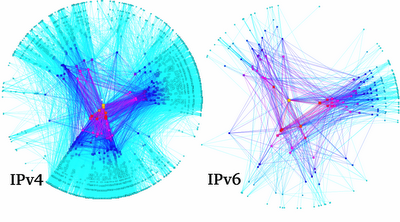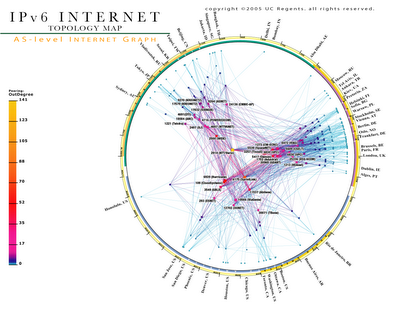If you have a look at the IPv6 graphic they made, you'll notice some interesting facts like, for instance, Europe is the country that has the most IPv6 Nodes. However the most observed node is NTT/Verio one in Japan. You can find it near the center of the more detailed IPv6 topology graphic.
 In comparison with the IPv4 AS graph, the IPv6 AS graph is much sparser with drastically fewer nodes and less richness of peering observed. The geographical patterns of the graphs also differ. While the majority of ISPs with the highest outdegrees in IPv4 space are all located in the U.S., the company with the richest observed IPv6 peering is NTT/Verio headquartered in Japan, with 141 peers. The largest cluster of high degree IPv6 AS nodes is in Europe (clustered around Tiscali which is headquartered in Germany) in the graph.
In comparison with the IPv4 AS graph, the IPv6 AS graph is much sparser with drastically fewer nodes and less richness of peering observed. The geographical patterns of the graphs also differ. While the majority of ISPs with the highest outdegrees in IPv4 space are all located in the U.S., the company with the richest observed IPv6 peering is NTT/Verio headquartered in Japan, with 141 peers. The largest cluster of high degree IPv6 AS nodes is in Europe (clustered around Tiscali which is headquartered in Germany) in the graph. Of the dominant ASes in the IPv4 AS graph, only SprintLink and UUNET are near the core in the IPv6 graph, and only SprintLink shows rich IPv6 connectivity. This disparity is consistent with the U.S. industrial attitude toward IPv6 as still more experimental rather than operational reality.
 This visualization represents a macroscopic snapshot of the IPv6 Internet topology collected around March 4th, 2005. Topology data gathered from 17 monitors probing approximately 860 globally routable IPv6 network prefixes include 2,913 IPv6 addresses and 7,905 IPv6 links (immediately adjacent addresses in a traceroute-like path).
This visualization represents a macroscopic snapshot of the IPv6 Internet topology collected around March 4th, 2005. Topology data gathered from 17 monitors probing approximately 860 globally routable IPv6 network prefixes include 2,913 IPv6 addresses and 7,905 IPv6 links (immediately adjacent addresses in a traceroute-like path). We aggregate this view of the network into a topology of Autonomous Systems (ASes). Each AS approximately corresponds to an Internet Service Provider (ISP). We map each IPv6 address to the AS responsible for routing it, i.e., to the origin (end-of-path) AS for the IPv6 prefix representing the best match of this address in Border Gateway Protocol (BGP) routing tables. We use the largest publicly available set of core BGP routing tables, collected by RIPE. The resulting abstracted AS graph consists of 333 Autonomous System (AS) nodes and 1,304 AS-links (peering sessions).
No comments:
Post a Comment